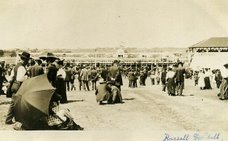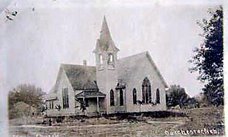 Centennial history book, religion played a vital role in the lives of the people who settled Nebraska.
Centennial history book, religion played a vital role in the lives of the people who settled Nebraska. In the early 1870s, a small group of German immigrants who settled northeast of Dorchester formed the first organized church, an Evangelical congregation. Soon after, other rural churches appeared in the Dorchester area countryside, including churches of Methodist, Christian and Congregational denominations.
In the fall of 1872, Rev. W.D. Gage moved to Dorchester from Nebraska City. He conducted services in the old frame school house, which was the only public building in town. Meanwhile, in the West Blue Area northeast of town, a growing Evangelical congregation attended services in a log home until 1875, when a small church was erected for $450. Dorchester's first church building came in 1879, with the construction of the Congregational Church that stood one block north and one block west of the  present post office.
present post office.
 present post office.
present post office. In 1880, the Methodist Church building came to Dorchester after town residents went to Pleasant Hill and tore down the structure and hauled it back by wagon. The Dorchester Methodist minister at that time, Rev. John Armstrong, was "a spirited man" according to accounts and did not mind controversy. In fact, he was also an attorney whose clients included two saloon keepers in Dorchester, considered by some to be a "city of rum."
As Dorchester's population increased in the 1880s, more rural churches appeared in the area, including two churches southwest of town (both United Brethren) and one northwest of town (Evangelical). Another denomination mentioned in the Dorchester Star was the "Dunkards," who apparently had no permanent house of worship. The  Dunkards baptised converts in Turkey Creek. Also, in 1884, a Baptist group was formed and they went on to build the First Baptist Church of Dorchester (pictured at right).
Dunkards baptised converts in Turkey Creek. Also, in 1884, a Baptist group was formed and they went on to build the First Baptist Church of Dorchester (pictured at right).
 Dunkards baptised converts in Turkey Creek. Also, in 1884, a Baptist group was formed and they went on to build the First Baptist Church of Dorchester (pictured at right).
Dunkards baptised converts in Turkey Creek. Also, in 1884, a Baptist group was formed and they went on to build the First Baptist Church of Dorchester (pictured at right).By the turn of the century, local churches were becoming stronger due to more population stability and financial prosperity. In 1904, a new Methodist Church was built (pictured above left); the building would serve the needs of the community until the turn of the next century, when the current Dorchester Methodist Church was built. Also in 1904, a new parsonage was erected for the West Blue Church northeast of town (pictured at top). In 1908, the Christian congregation also built a new church in town (pictured at lower left). It  included a tank behind the alter, since the Christian faith practiced total immersion for baptism. Previously, baptism had been held at Turkey Creek or the Blue River. By the 1910s, the rural churches found it difficult to keep their doors open, as people were no longer isolated within their own small rural neighborhoods, thanks to automobiles and better roads.
included a tank behind the alter, since the Christian faith practiced total immersion for baptism. Previously, baptism had been held at Turkey Creek or the Blue River. By the 1910s, the rural churches found it difficult to keep their doors open, as people were no longer isolated within their own small rural neighborhoods, thanks to automobiles and better roads.
 included a tank behind the alter, since the Christian faith practiced total immersion for baptism. Previously, baptism had been held at Turkey Creek or the Blue River. By the 1910s, the rural churches found it difficult to keep their doors open, as people were no longer isolated within their own small rural neighborhoods, thanks to automobiles and better roads.
included a tank behind the alter, since the Christian faith practiced total immersion for baptism. Previously, baptism had been held at Turkey Creek or the Blue River. By the 1910s, the rural churches found it difficult to keep their doors open, as people were no longer isolated within their own small rural neighborhoods, thanks to automobiles and better roads.Looking back at our area's earliest years, it becomes clear that many of the first settlers had few possessions, but carried a devout faith in God. Not only did that shared faith offer comfort and hope, but it also united them. More than 130 years later, the same can hold true for Dorchester residents.


















































Awesome article and pictures! Thanks Village Dweller! I grew up in the Methodist church in Dorchester. It was even my first job - as janitor with my family and then on my own (and the first job I was fired from - rightly so!) I always thought it was the only denomination that ever was in Dorchester, thanks for the history lesson!
ReplyDeleteAwesome heritage. I wonder whatever happened to some of those old churches?
ReplyDeleteI would also like to thank you for the history lesson. Great article w/fantastic pictures. I remember my Grandmother telling us about how many churches use to be in Dorchester.
ReplyDeleteThis is a worthwhile article. I think the Dorchester centennial book should be required reading in the 4th grade when they teach state history. Has Dorchester Schools considered doing this? I'd love to hear from school officials.
ReplyDeleteToo bad you couldn't find a picture of the Methodist Church when it got stuck in the ditch, obstructing Hwy 103 south of Crete, when it was being moved. That was quite a site!
ReplyDeleteThe religious history of Dorchester and all of Saline County is very interesting. The Czechs, especially in the Wilber area, were known as Free Thinkers. My mother's family left the "old country" because they did not wish to remain Roman Catholic. Many of the Free Thinkers in Saline County opted not to join a church and instead became active in fraternal organizations.
ReplyDeleteDorchester has such great historical stories, which include buildings. Interesting that there are no beautiful buildings around to show off!! Too bad, I would love to see them still standing, preserved, and still useful today. Something an old town could be proud of and show off.
ReplyDeleteWe have plenty of older homes to show off, some of which just need a little TLC. But why put much money in them when you have a gravel/dirt road in front of your house?????
ReplyDeleteHave attended services many a time at West Blue, when a child and young adult. Unfortunately, services are no longer regularly held there. Wonderful to see this photo.
ReplyDelete